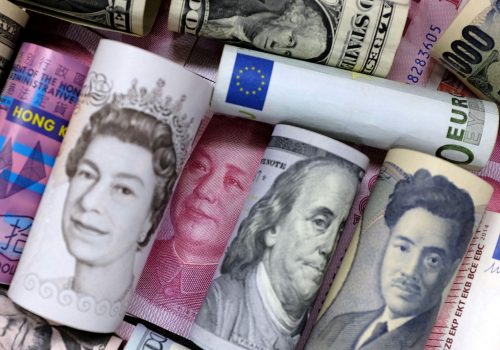February 9, 2022
US fiscal policy must be ready for the return of secular stagnation
US GDP growth and inflation are at multi-decade highs but in the years preceding the COVID-19 pandemic the US economy often featured below-target inflation, slow economic growth, and low interest rates. Despite the recent uptick in growth and higher than expected inflation, ten-year real interest rates are negative. This development is not as surprising as it might seem because real interest rates across advanced economies have steadily declined for over 30 years due to structural factors. Evidence suggests that the long-run dynamics driving US interest rates and GDP growth down are likely to continue in the medium to long term. Looking forward, US policymakers will retain the ability and impetus to utilize fiscal policy to boost growth given low interest rate trends.
Over the past decade former Secretary of the Treasury Larry Summers revitalized the term secular stagnation to describe persistent economic conditions in the United States and other advanced economies. The expression was first used to explain the economic environment the United States faced in the 1930s following the Great Depression. The term describes economies enduring chronic shortfalls in private demand and investment, excess savings, and an imbalanced market equilibrium for capital that lowers interest rates, growth, and inflation. Consistently low rates driven by low demand also contribute to supply side contractions that reduce economic growth and productivity.
A key question for US fiscal policy in the decade ahead is if the current inflationary bout will fundamentally alter the secular stagnation paradigm the US economy was in, or if this episode will be a shorter-term event. To answer this question, it is important to unpack the rise of secular stagnation in recent decades and current inflationary pressures.
Since the late 1970’s savings in the United States and globally from households, firms, and governments accumulating foreign-reserves have increased, leading to a global savings glut as former Fed chairman Ben Bernanke phrased it. In turn, real interest rates across advanced economies have steadily declined, even in instances when they should theoretically rise such as a tight labor market or significant government spending. For example, the 10-year yield for Treasury Inflation-Protected Securities, introduced in 1997, has lurched downward for much of the past two decades. The rate is currently negative, which means the United States can pay back less than it borrowed in real terms in ten years.
There is no single cause of secular stagnation, but several variables appear to contribute. A major factor is shifting demographics. Population growth in the United States and other advanced economies has slowed for decades. With fewer prime-age workers, there is less consumption and motivation for businesses to invest in expanding capacity. Longer life expectancy means people spend more of their time retired and need to save more. Increased economic inequality also played a role. Wealthier households have a lower marginal propensity to consume and tend to save more, and their share of total capital has grown. Some prominent economists also point out the rise of digital technology advancement, noting that digital technologies are less capital intensive and generate less investment demand compared to prior technological revolutions.
Regardless of the precise causes of secular stagnation, it has important implications for fiscal policy. First, frequently low interest rates give policymakers more fiscal space, or the flexibility to make budgetary decisions without sacrificing financial sustainability, to operate in. When the real interest rate on safe financial assets, such as US treasuries, is less than real GDP growth, a government can run deficits while maintaining stable debt to GDP ratios because the economy is growing faster than the interest accruing on its debt. During the pandemic the United States ran its largest fiscal deficits since World War II. However, the increase in GDP growth combined with low interest rates led to faster debt stabilization than previously predicted.
Secular stagnation also requires more expansive fiscal policy. Increased government investment boosts demand to consistent and sufficient levels, such that private investment is crowded in as businesses accelerate their spending to expand supply capacity. This reinforcing cycle alleviates ongoing demand and investment shortfalls and leads to higher GDP growth.
While this premise holds under certain economic parameters, it doesn’t mean that governments have infinite fiscal space without generating inflation or higher interest rates, or that spending is always worthwhile. For instance, some emerging markets with different macroeconomic circumstances are experiencing faster interest rate increases following government stimulus. Some economists suggest using real debt servicing costs compared to GDP to guide fiscal space. Others argue governments should focus on making budgetary changes more automatic, based on distress indicators and interest rate conditions. Many experts do agree that extending debt maturities to lock in low rates, and investing in areas such as climate change, infrastructure, and education — where the benefits to growth outweigh the low servicing costs — makes sense.
High inflation, and its potential duration, must also be a part of the fiscal policy calculus. Data suggest an unusual mix of pandemic-initiated factors is increasing inflation. These include elevated demand driven by short-term fiscal stimulus and loose monetary policy, skewed demand composition towards goods and away from services, supply chain disruptions, and a hot but still recovering labor market. At the same time, the pandemic has accelerated some underlying longer-term structural trends behind secular stagnation. These trends will likely continue after pandemic disruptions fade.
Considering these factors, and the Fed’s crucial commitment to tame inflation, relevant experts and stakeholders do not seem to expect above target inflation beyond the next few years. Consumer expectations, economic forecasters, and bond market data points indicate the anticipation of a return to the low-rate and low-growth characteristics of secular stagnation in the coming years.
Experts concerned about inflation over the past year, including Larry Summers — who warned about the risk of inflation well before most — have also predicted that the return of secular stagnation and low growth is probable in the next few years. Thus, many also recommend growth inducing fiscal investments. For example, the Biden administration’s Build Back Better agenda received support from a wide array of economists despite the present inflation burst. The proposals are appealing because they are spread out over ten years, real interest rates are negative, and they make crucial investments in areas evidenced to show increased US growth potential, productivity, and well-being.
In the years ahead the United States will likely move past current inflation challenges and will once again be battling secular stagnation. Although today’s inflation caught many by surprise and poses risks, it is important for policymakers to keep perspective on the economy’s long-term needs. If the United States is to overcome the difficult challenges ahead, its fiscal space must be recognized and used in a sustained, efficient, and thoughtful manner.
Jeff Goldstein is a contributor to the Atlantic Council’s GeoEconomics Center. During the Obama administration he served as the Deputy Chief of Staff and Special Assistant to the Chairman of the White House Council of Economic Advisers. He also worked at the Peterson Institute for International Economics. Views and opinions expressed are strictly his own.

At the intersection of economics, finance, and foreign policy, the GeoEconomics Center is a translation hub with the goal of helping shape a better global economic future.
Related reading
Image: The central banking system of the United States and changing interest rates. Percentage symbol and arrow symbol on the wooden cube.

